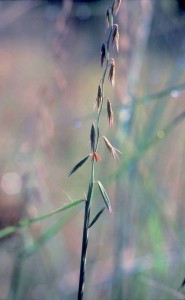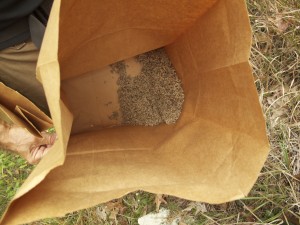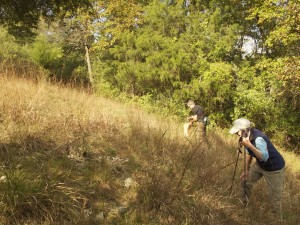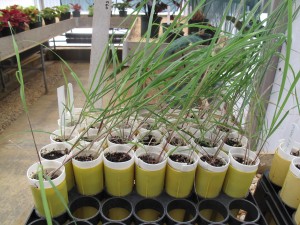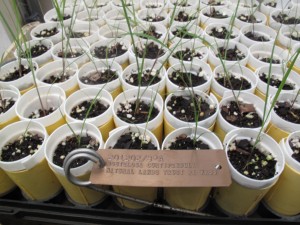Unionville Serpentine Barrens plant conservation
Posted by William Ryan, NLT researcher
Last October, as we counted the last of the warm days of Indian summer, seeds were ripening and dispersing at the Unionville Serpentine Barrens. Acorns were dropping, and the grasses were preparing their offspring for a wind-born adventure. A certain grass species was on the minds of Natural Lands Trust’s scientific advisers and researchers. Its name is Bouteloua curtipendula (surely a mouth-full even for botanists), more commonly referred to as side-oats grama.
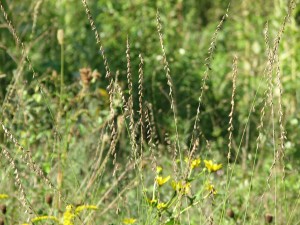
Side-oats grama is one of the many uncommon native grass species found at the Unionville Serpentine Barrens (photo: Roger Latham)
In Pennsylvania, it is found rarely in a few specific habitats and localities, such as calcareous clearings in central PA, and on the serpentine barrens of Chester County. So here we found ourselves last year, on a crisp early autumn afternoon – low humidity and plenty of sunshine – two desirable conditions for grass-seed collection. Permission was secured to collect seed from a fragmented population of side-oats grama on private property directly adjacent to our ChesLen Preserve, which encompasses a critical part of the Unionville Serpentine Barrens, a globally rare ecosystem.
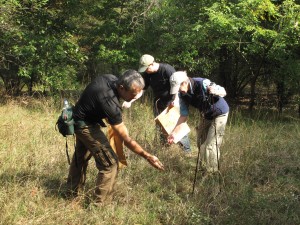
Side-oats grama collection in one of a half dozen small patches at the Unionville Serpentine Barrens
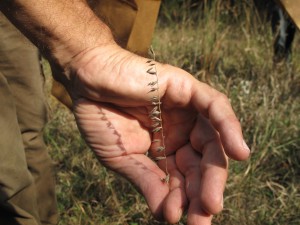
The plants could easily be identified by their unique seeds – all facing one side.
The purpose of our seed collection endeavor was to initiate a propagation program for some of the rare species found on the barrens at Unionville – of which there are at least 19, according to the Pennsylvania Natural Heritage Program. An arrangement was made with Mt. Cuba Center, in Hockessin, DE, to have them attempt to grow 500 plants, to be used in a carefully planned and monitored introduction to suitable habitat on the NLT-owned portion of the barrens. After clearing nearly ten acres of forest surrounding the shrinking grasslands in September, to be followed by a prescribed burn later this year, the area will be ripe for planting native grass and wildflower seeds, along with the side-oats grams plugs – products of Mt. Cuba Center’s propagation efforts.
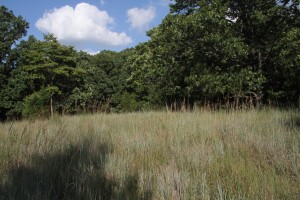
Late summer 2012. Although small, these grassland remnants serve as refuges for populations of rare plant species.
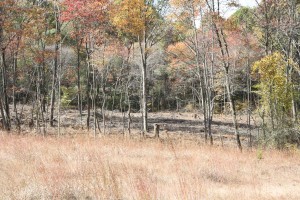
In the foreground lies existing serpentine grassland; in the background, potential grassland in a newly cleared portion of the barrens.
We were able to collect a significant amount of seeds, and we left with a very light paper bag filled with a valuable substance – the unique genetic stock of one of only four occurrences of side-oats grama on serpentine soils in Pennsylvania.
The plants were delivered for drying and preparation by Mt. Cuba staff, and within weeks were in trays under warmth, moisture, and light – spring right after fall. We had heard that side-oats grama could be difficult to propagate, and could be subject to low seed viability, but we waited patiently for their awakening from the soil – coaxed by artificial lights, mist, and heated beds. By December, a few dozen seedlings had emerged, and were transferred from flats to individual growth chambers – 8 inch deep tubes that facilitate the growth of a healthy root system.
In addition to this first wave of growth, nearly a hundred more seedlings emerged over the winter. This exciting news will be even more exciting when we install the plants this year. A monitoring protocol will be established and executed, to track the survival and health of the young plants. We will report our results to NLT’s Conservation and Stewardship Departments, and Mt. Cuba Center’s greenhouse staff. Our goal is to continue to propagate these rare species, and continue building partnerships with like-minded organizations and landowners who appreciate the importance of the conservation and stewardship of our region’s unique biological resources. Perhaps someday soon we will collect seed from these very same plants, and continue to help Bouteloua curtipendula and many other characteristic serpentine barren plant species thrive in this fascinating ecosystem in Unionville.

